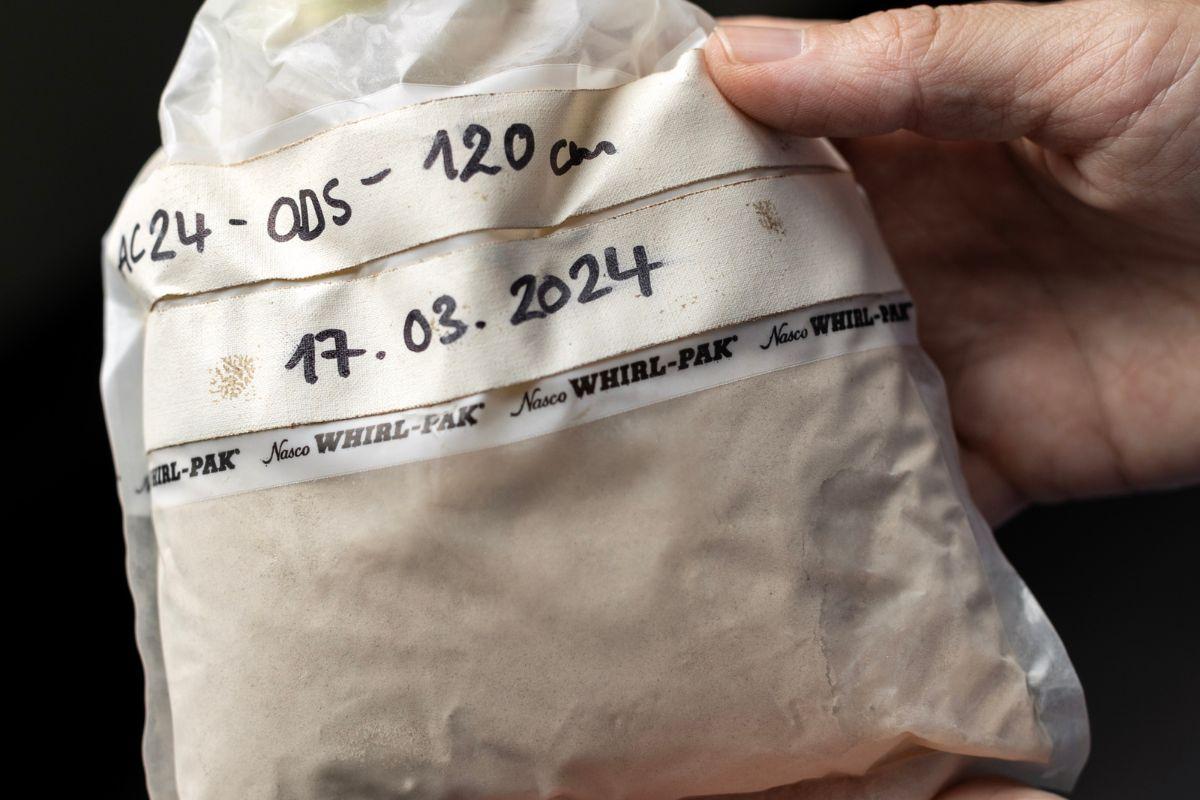Cosmic dust that falls to Earth can tell us a lot about the history of our solar system. Astrophysicist Jenny Feige collects extraterrestrial particles in the Chilean Atacama Desert to gaze millions of years into the past.
At night, the past takes over the desert. A celestial sky of overwhelming depth and perfection stretches out over the sea of sand, a coordinate system of shimmering light that has travelled to us over millions of years. "When I'm lying on the ground there, I feel like I have to hold on tight so that I don't take off," says Jenny Feige. She can look up into the southern sky for hours, where the stellar constellation Orion is upside down and the wispy Magellanic Clouds shine next to the Milky Way. The astrophysicist from the Museum für Naturkunde Berlin is a chronicler of the universe. She collects the dust from exploded stars and disintegrated asteroids that falls to Earth in order to reconstruct cosmic events such as supernovae and asteroid collisions that may have influenced our solar system and the evolution of our planet.
Jenny Feige has found a tremendous archive in the arid Atacama Desert in northern Chile: Cosmic material has been deposited here more reliably than almost anywhere else on Earth, because only about one millimetre of rain falls per year to wash it away. "The desert is a kind of memory of the last ten million years of our solar system," says Feige, who spends several weeks in the Atacama every year. She and her team collect samples during the day and sleep under the stars at night.
The extraterrestrial dust that Feige tracks is constantly trickling down to Earth. It consists of two classes. Interplanetary dust originates from within our solar system and is created when two asteroids collide, an asteroid hits a planet or a comet melts near the sun. The remnants of such events travel in a huge spiral towards the sun and also pass through the giant dust collector Earth. Around 100 tonnes of interplanetary particles fall onto the oceans and continents every day. The smallest of these are only a tenth of a millimetre in size, while the larger ones - known as micrometeorites - can measure up to two millimetres.
The second class of dust, interstellar dust, is mainly produced by stellar explosions and is much finer - only nanometres to micrometres in size (one millionth to one-thousandths of a millimetre). Its atoms form new molecules in the Earth's atmosphere, bind to aerosols and gradually sink down. "They contain the isotope signatures of exploding stars," says Feige. If, for example, the isotope iron-60 can be detected in a sediment layer of the Atacama, it is likely that cosmic dust from a supernova trickled down to Earth at the time of its formation. This is because iron only occurs on Earth itself with 28 to 32 neutrons in its atomic nucleus; iron-60, with 34 neutrons, requires the explosion of a high-mass star.

Atacama dust as excess baggage
Jenny Feige spent two months collecting sediments in the Atacama Desert with her team and Chilean geologists in spring 2024. They mined with shovels, dug holes, broke up the rock with jackhammers and took samples from outcrops and abandoned mines. They were able to penetrate to a depth of 43 metres. In total, they collected 120 kilograms of Atacama dust, which they neatly labelled and took back to Berlin as excess baggage.
Feige and her team received an ERC Starting Grant from the European Union to analyse the Atacama samples and gain new insights from them. It has been known since 2004 that a supernova must have occurred two to three million years ago in the so-called local superbubble - a space created by stellar explosions that our solar system is currently travelling through. Another supernova can be detected a good seven million years ago in another superbubble. "We now want to find out whether further explosions and asteroid collisions have occurred," says Feige. The sediments of the Atacama could provide detailed answers. "In cooperation with climate research, we also want to investigate the question of how cosmic events affect the Earth," says Feige. "For example, by attacking the ozone layer, stimulating cloud formation or attenuating sunlight and changing the climate."
Star research in the deep sea
Jenny Feige was already fascinated by the stars as a teenager. She devoured every book she could get her hands on about the universe. In Woltersdorf near Berlin, where she grew up, she looked at the stars at every opportunity and decided to buy a telescope at the age of 18. Soon after using it to observe Saturn and the moons of Jupiter for the first time, she enrolled at the University of Vienna to study astronomy. She was first fascinated by exoplanets, which orbit their stars in other solar systems.. Then the subtle trace of extraterrestrial iron-60 on Earth. For her master's thesis, she calculated which star clusters may have just passed by our solar system when the supernova exploded at 2-3 million years ago. "That was very theoretical, without any samples or measurements."
She was so fascinated by the iron-60 that she quickly approached an isotope researcher from the University of Vienna, who had helped discover the supernova in 2004: Anton Wallner. "He was just starting a project for deep-sea astronomy and I was able to start my doctoral thesis with him straight after a nuclear physics internship," says Feige. They analysed dozens of samples from sediment cores from all over the world's oceans for iron-60 and found what they were looking for. Not only did they find traces of the supernova that exploded two to three million years ago, they were also able to detect the second supernova six to eight million years ago on the ocean floor. The results were published in the renowned scientific journal Nature in 2016. Feige soon moved from Vienna to Berlin, first to the Technical University for Theoretical Astrophysics, where she studied micrometeorites for the first time, then in 2023 to the Museum für Naturkunde Berlin to devote more time to experimental astronomy.

Iron-60 in the accelerator mass spectrometer
Dozens of sample bags of Atacama sediments are stored in Feige's laboratory at the Museum für Naturkunde Berlin, waiting to be analysed. Her colleagues first remove salts and gypsum from the samples in beakers and then sort them by grain size in a vibrating machine with sieves. Using an optical microscope, they search for micrometeorites, which lie shimmering black or silver-grey between the earthly silicates. "We analyse their chemical composition in order to be able to say what type of asteroid they come from," says Feige. With the help of radiocarbon elements, they can also determine how long the dust grain has been travelling in space and when and where in the solar system it could have originated.
Detecting the rare iron-60 is more difficult, as it only exists in extremely small quantities on Earth. The supernova two to three million years ago distributed a maximum of 20 kilograms of iron-60 over the entire Earth. This wafer-thin trace can only be measured with a worldwide unique accelerator mass spectrometer in Canberra, Australia. Jenny Feige looks curiously at her monitor. Soon the latest results will flutter in again from Canberra - measurements of tiny isotopes from which she will gradually write a chronicle of the explosive history of our solar system.
